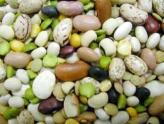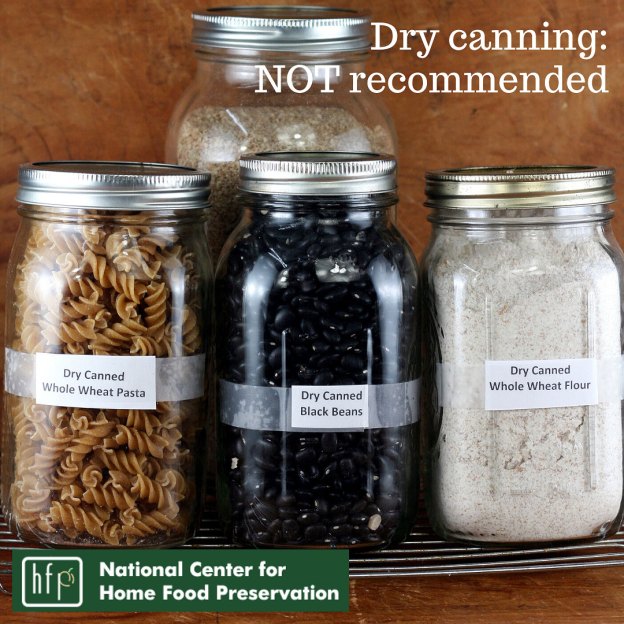Quite a few people are circulating directions for what they call “dry canning” as a method of storing dried foods. It is not a food preservation method we recommend.
What is canning?
Just because canning jars are used in “dry canning” does not mean the suggested procedures fit the classic definition of canning.
Canning as a method of food preservation or processing refers to a procedure of heat treating closed containers of food with the goal of producing what is called a “commercially sterile”, vacuum sealed-food that can then be stored safely at room temperature. The preservation goal is to kill any spoilage and pathogenic (harmful) microorganisms that otherwise would be able to survive in food at room temperature storage. In some categories of foods, bacteria can also be controlled by acidity or moisture control as well as the heat of canning. In other foods (e.g., low-acid or slightly acid foods) heat usually has to do the whole job. Different foods will have different microorganisms targeted for killing or control, depending on the nature of the food.
Why dry canning isn’t canning
Canning is done with moist foods because the moisture inside the container would support the growth of microorganisms. Dried foods do not have the same concerns even if a food is low-acid because the removal of available moisture limits or prevents the growth of microorganisms. Storage of dried foods for long periods of time will take into consideration means to preserve food quality, however, as well as preventing reabsorption of moisture into the food.
“Dry canning” techniques I see circulating call for putting dried food like grains, beans, and nuts, into canning jars. In some methods, canning lids are then placed on the jars and the jars heated in an oven. Usually about 200°F is recommended. In other directions, the food in jars is heated without the lids, which are then placed on the jars when they come out of the oven.
These procedures do not describe true canning preservation of food but instead would be considered a method of packaging dried foods for storage — one that, again, we cannot recommend because of several issues with it.
Issues with dry canning
Here are some issues to think about with this concept:
- This process is not “canning” just because it uses canning jars.
- It is unknown if this process can sterilize the food, although it might cause vacuum sealing of jars. This would not be a time and temperature combination known to kill many bacterial spores or mold spores.
- This method does not remove all of the oxygen from the jar before sealing and may trap moisture from the food if condensation occurs. While the presence of spores would not be an issue in very dry foods, any moisture pockets say from condensation or incompletely dried foods could be a problem. Moisture in the jar with some retained oxygen could support the growth of airborne molds or even bacteria not killed by the low heating in some seemingly dry foods. Some foods may seem dry to the consumer but still have enough moisture in them to come out upon heating and closing up in a container. This could be especially true of home dried foods.
- The dry oven process used at home has never been shown to sterilize these various dry foods or produce the claimed extended shelf life with quality. In fact, there is no known researched shelf life for foods packaged just this way at home. (If someone can lead me to the research I have not been able to find, please let me know.) Extended shelf life expectations are available for dry foods prepared and packaged by other methods (see the Utah State University Extension references below).
- This heating could even make the quality of some foods worse. This could be either by moisture condensation upon cooling, or if the food is lipid-containing nuts and grains, increased enzymatic reaction causing rancidity.
- A major manufacturer of canning jars and lids in the U.S. does not support the use of their jars and lids/sealing compound in this manner.
- Because this type of process is not recommended, doing it can be a waste of resources, time and energy.
Recommended storage methods for dry goods

Photo by E. Andress
Thoroughly dried foods can be stored a fairly long time in airtight containers at moderate room temperatures or in the freezer. If you want to vacuum seal containers of dry foods, methods that will preserve them safely and provide better food quality include:
(1) A vacuum sealing machine that has adapters for jars in addition to sealing bags if you want your food in jars. This vacuum packaging is done at room temperature without heating the food.
(2) Oxygen absorbers inside your containers of these foods. Oxygen absorbers can help preserve the quality of foods and also aid in insect control.
(3) If you are using the heating method to control for possible insect contamination of your dried food, the Utah State University booklet linked below has methods for heating and then cooling dry foods BEFORE they are packaged for storage. It also describes freezing procedures before packaging as an alternative to insect control. Even heating some foods on an open oven tray before packaging can cause some flavor changes that using the freezing method would not.
Utah State University Extension methods, for example, for long-term storage of dry rice and beans:
10-year storage of rice: https://extension.usu.edu/foodstorage/howdoi/white_rice
10 or more years for beans: https://extension.usu.edu/foodstorage/howdoi/dry_beans
And here is a large book/booklet from Utah State University about storing food, A Guide to Food Storage for Emergencies, with more specific information and the oven or freezing methods for insect control:
https://extension.usu.edu/foodstorage/ou-files/Food_Storage_Booklet2.pdf
I would like to thank my colleagues in some other states for helping to review and contribute to these points. Nancy Flores at New Mexico State University helped get some organization and formatting to them, and Karen Blakeslee at Kansas State University helped with review and additions. There were others who initially reviewed my first version and I thank them also.
###
